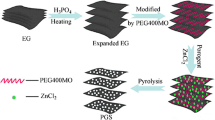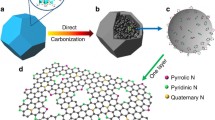Abstract
A hierarchical structure of nitrogen-doped porous carbon coated on graphene sheets (GNC) has been successfully synthesized via a facile method. Notably, nitrogen-doped porous carbon (NC) was prepared by direct calcinations of sodium citrate and urea without aid of any additional carbon source and template. The porous structure arises from the decomposition of sodium citrate and the formative Na2CO3 is the hard template during the annealing process. To our pleasure, the 3D architecture is derived from the graphene sheets as skeleton to support porous carbon, which avoids the agglomeration of graphene and enlarges the specific surface area of porous carbon. Besides, using urea as resource of N element promotes a high N-doping level (3.33 atom %) and improves electrical conductivity and lithium storage sites. Thus, the obtained GNC-700 °C as an anode material delivers a high-reversible capacity of 842.7 mAh g−1 at 0.1 A g−1 and good cycling performances (431.4 mAh g−1 at 0.5 A g−1 after 200 cycles). The distinguished carbon anode material demonstrates an appealing development for Li-ion batteries.








Similar content being viewed by others
References
Wang F, Wu X, Li C, Zhu Y, Fu L, Wu Y, Liu X (2016) Nanostructured positive electrode materials for post-lithium ion batteries. Energy Environ Sci 9:3570–3611
Kim H, Kim H, Ding Z, Lee MH, Lim K, Yoon G, Kang K (2016) Recent progress in electrode materials for sodium-ion batteries. Adv Energy Mater 6:1600943
He Y, Chen W, Li X, Zhang Z, Fu J, Zhao C, Xie E (2013) Freestanding three-dimensional graphene/MnO2 composite networks as ultralight and flexible supercapacitor electrodes. ACS Nano 7:174–182
Su L, Gao L, Du Q, Hou L, Ma Z, Qin X, Shao G (2018) Construction of NiCo2O4@MnO2 nanosheet arrays for high-performance supercapacitor: highly cross-linked porous heterostructure and worthy electrochemical double-layer capacitance contribution. J Alloys Compd 749:900–908
Liu W, Li X, Xiong D, Hao Y, Li J, Kou H, Yan B, Li D, Lu S, Koo A, Adair K, Sun X (2018) Significantly improving cycling performance of cathodes in lithium ion batteries: the effect of Al2O3 and LiAlO2 coatings on LiNi0.6Co0.2Mn0.2O2. Nano Energy 44:111–120
Jin R, Li X, Sun Y, Shan H, Fan L, Li D, Sun X (2018) Metal–organic frameworks-derived Co2P@N-C@rGO with dual protection layers for improved sodium storage. ACS Appl Mater Interfaces 10:14641–14648
Fan L, Li X, Song X, Hu N, Xiong D, Koo A, Sun X (2018) Promising dual-doped graphene aerogel/SnS2 nanocrystal building high performance sodium ion batteries. ACS Appl Mater Interfaces 10:2637–2648
Tarascon JM (2010) Is lithium the new gold? Nat Chem 2:510
Sun G, Yin X, Yang W, Zhang J, Du Q, Ma Z, Shao G, Wang Z (2018) Synergistic effects of ion doping and surface-modifying for lithium transition-metal oxide: synthesis and characterization of La2O3-modified LiNi1/3Co1/3Mn1/3O2. Electrochim Acta
Xu W, Xie Z, Cui X, Zhao K, Zhang L, Mai L, Wang Y (2016) Direct growth of an economic green energy storage material: a monocrystalline jarosite-KFe3(SO4)2(OH)6-nanoplates@rGO hybrid as a superior lithium-ion battery cathode. J Mater Chem A 4:3735–3742
Nishihara H, Kyotani T (2012) Energy storage: templated nanocarbons for energy storage (Adv. Mater. 33/2012). Adv Mater 24:4466–4466
Kaskhedikar NA, Maier J (2010) Lithium storage in carbon nanostructures. Adv Mater 21:2664–2680
Li D, Ding LX, Chen H, Wang S, Li Z, Zhu M, Wang H (2014) Novel nitrogen-rich porous carbon spheres as a high-performance anode material for lithium-ion batteries. J Mater Chem A 2:16617–16622
Guo DC, Han F, Lu AH (2015) Porous carbon anodes for a high capacity lithium-ion battery obtained by incorporating silica into benzoxazine during polymerization. Chem 21:1520–1525
Zhu C, Akiyama T (2016) Cotton derived porous carbon via an MgO template method for high performance lithium ion battery anodes. Green Chem 18:2106–2114
Lu P, Sun Y, Xiang H, Liang X, Yu Y (2018) 3D amorphous carbon with controlled porous and disordered structures as a high-rate anode material for sodium-ion batteries. Adv Energy Mater 8
Li Z, Xu Z, Tan X, Wang H, Holt CMB, Stephenson T, Olsen BC, Mitlin D (2013) Mesoporous nitrogen-rich carbons derived from protein for ultra-high capacity battery anodes and supercapacitors. Energy Environ Sci 6:871–878
Wu Y, Fang S, Jiang Y (1998) Carbon anode materials based on melamine resin. J Mater Chem 8:2223–2227
Chen L, Song L, Zhang Y, Wang P, Xiao Z, Guo YG, Cao F (2016) Nitrogen and sulfur co-doped reduced graphene oxide as a general platform for rapid and sensitive fluorescent detection of biological species. ACS Appl Mater Interaces 8:11255
Yin G, Gao Y, Shi P, Cheng X, Aramata A (2003) The effect of boron doping on lithium intercalation performance of boron-doped carbon materials. Mater Chem Phys 80:94–101
Hou J, Cao C, Idrees F, Ma X (2015) Hierarchical porous nitrogen-doped carbon nanosheets derived from silk for ultrahigh-capacity battery anodes and supercapacitors. ACS Nano 9:2556–2564
Shin WH, Jeong HM, Kim BG, Kang JK, Choi JW (2012) Nitrogen-doped multiwall carbon nanotubes for lithium storage with extremely high capacity. Nano Lett 12:2283–2288
Li J, Lu L, Kang T, Cheng S (2016) Intense charge transfer surface based on graphene and thymine–Hg (II)–thymine base pairs for detection of Hg2+. Biosens Bioelectron 77:740–745
Eda G, Lin YY, Mattevi C, Yamaguchi H, Chen HA, Chen IS, Chen CW, Chhowalla M (2010) Blue photoluminescence from chemically derived graphene oxide. Adv Mater 22:505–509
Zhu D, Wang L, Xu X, Wei J (2016) Label-free and enzyme-free detection of transcription factors with graphene oxide fluorescence switch-based multifunctional G-quadruplex-hairpin probe. Biosens Bioelectron 75:155–116
Chen Y, Zhang X, Yu P, Ma Y (2009) Stable dispersions of graphene and highly conducting graphene films: a new approach to creating colloids of graphene monolayers. Chem Commun 30:4527
Mukherjee R, Thomas AV, Krishnamurthy A, Koratkar N (2012) Photothermally reduced graphene as high-power anodes for lithium-ion batteries. ACS Nano 6:7867–7878
Xie Z, He Z, Feng X, Xu W, Cui X, Zhang J, Yan C, Carreon MA, Liu Z, Wang Y (2016) Hierarchical sandwich-like structure of ultrafine N-rich porous carbon nanospheres grown on graphene sheets as superior lithium-ion battery anodes. ACS Appl Mater Interfaces 8:10324–10333
Jr WSH, Offeman RE (1958) Preparation of graphitic oxide. J Am Chem Soc 80:1339
Ai W, Zhou W, Du Z, Du Y, Zhang H, Jia X, Xie L, Yi M, Yu T, Huang W (2012) Benzoxazole and benzimidazole heterocycle-grafted graphene for high-performance supercapacitor electrodes. J Mater Chem 22:23439–23446
Qian W, Sun F, Xu Y, Qiu L, Liu C, Wang S, Yan F (2013) Human hair-derived carbon flakes for electrochemical supercapacitors. Energy Environ Sci 7:379–386
Jang JW, Lee KS, Lyu SC, Lee TJ, Lee CJ (2004) Structural study of nitrogen-doping effects in bamboo-shaped multiwalled carbon nanotubes. Appl Phys Lett 84:2877–2879
Wei D, Liu Y, Wang Y, Zhang H, Huang L, Yu G (2009) Synthesis of N-doped graphene by chemical vapor deposition and its electrical properties. Nano Lett 9:1752–1758
Palaniselvam T, Biswal BP, Banerjee R, Kurungot S (2013) Zeolitic imidazolate framework (ZIF)-derived, hollow-core, nitrogen-doped carbon nanostructures for oxygen-reduction reactions in PEFCs. Chem 19:9335–9342
Zhao J, Lai H, Lyu Z, Jiang Y, Xie K, Wang X, Wu Q, Yang L, Jin Z, Ma Y (2015) Hydrophilic hierarchical nitrogen-doped carbon nanocages for ultrahigh supercapacitive performance. Adv Mater 27:3541–3545
Mao Y, Duan H, Xu B, Zhang L, Hu Y, Zhao C, Wang Z, Chen L, Yang Y (2012) Lithium storage in nitrogen-rich mesoporous carbon materials. Energy Environ Sci 5:7950–7955
Yang W, Yang W, Kong L, Song A, Qin X, Shao G (2017) Phosphorus-doped 3D hierarchical porous carbon for high-performance supercapacitors: a balanced strategy for pore structure and chemical composition. Carbon
Wang Z, Huang X, Chen L (1999) Lithium insertion/extraction in pyrolyzed phenolic resin. J Power Sources 81–82:328–334
Yang W, Yang W, Song A, Sun G, Shao G (2018) 3D interconnected porous carbon nanosheets/carbon nanotubes as a polysulfide reservoir for high performance lithium-sulfur batteries. Nanoscale 10:816–824
Dahn JR, Zheng T, Liu Y, Xue JS (1995) Mechanisms for lithium insertion in carbonaceous materials. Science 270:590–593
Zhou X, Chen F, Bai T, Long B, Liao Q, Ren Y, Yang J (2016) Interconnected highly graphitic carbon nanosheets derived from wheat stalk as high performance anode materials for lithium ion batteries. Green Chem 18:2078–2088
Funding
This research received financial support from the Natural Science Foundation of Hebei Province (B2018203330).
Author information
Authors and Affiliations
Corresponding author
Electronic supplementary material
ESM 1
(DOC 466 kb)
Rights and permissions
About this article
Cite this article
Su, L., Gao, L., Hou, L. et al. Nitrogen-doped porous carbon coated on graphene sheets as anode materials for Li-ion batteries. Ionics 25, 1541–1549 (2019). https://doi.org/10.1007/s11581-018-2713-1
Received:
Revised:
Accepted:
Published:
Issue Date:
DOI: https://doi.org/10.1007/s11581-018-2713-1




